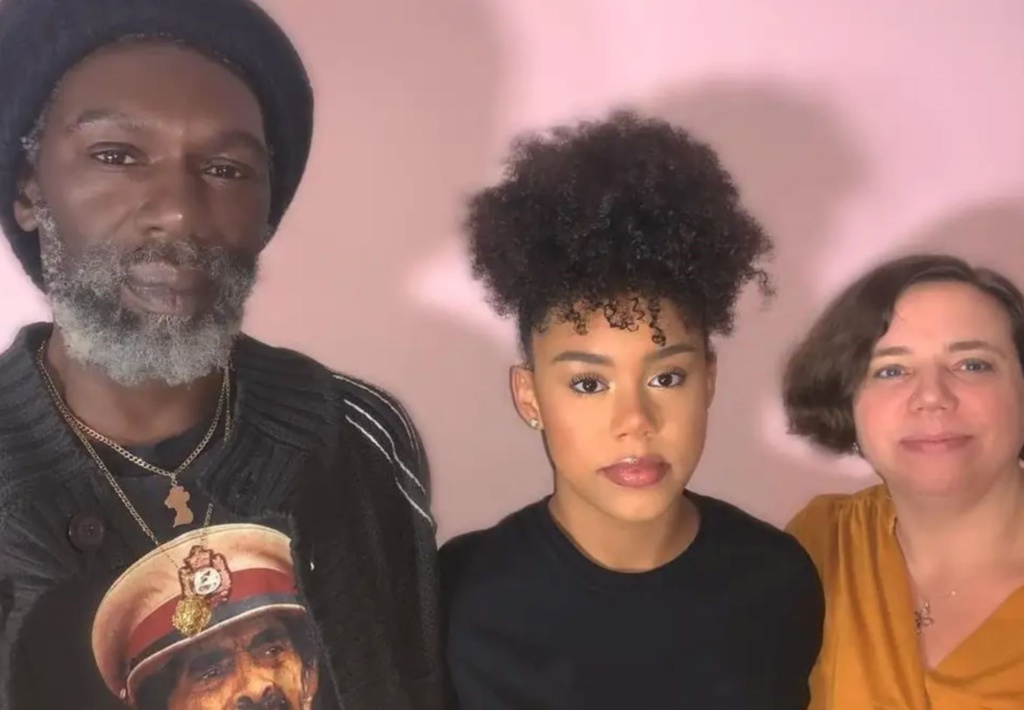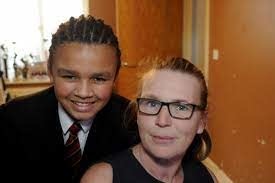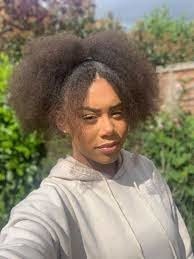
‘Afro hair is not treated well in society,’ says Michelle De Leon Founder and Director of World Afro Day and Features Producer on Good Morning Britain. ‘It can be seen as unprofessional, a messy-looking hair type, and something that is not normal. But it is actually just a normal hair type, the same way that everyone else’s hair type is normal’
This year World Afro Day on 15th September focused on education leaders and headteachers with the message that this is an equality issue for schools and asked them to play their part in ending for good discrimination against Afro hair in schools across the country.
The Association of School and College Leaders and the National Association of Head Teachers are supporting a campaign to stamp out unfair restrictions over black pupils’ appearances, often hidden in strictures over appearance and school uniform rules.
Unreasonable rules
A typical example from a school website reads: ‘Long hair must be combed downwards and very long hair must be tied back. Mohican hairstyles must not be worn. No design should be shaven into hair style or eyebrows. If a student’s hair style is not appropriate, he or she will be given a fixed period of time to change it. During this period they will be removed from lessons.’
Since Afro hair grows out from the head, rather than downwards, pupils will have a hard time complying with the school rules. One teacher took issue with schools in a TES article https://www.tes.com/news/my-outstanding-school-structurally-racist ‘On multiple occasions, pupils have been held in our internal exclusion unit for having hair grow naturally out of their scalps. They have been told to cut it off, or they will not be allowed back in class.’
Dreadlocks caused exclusion
This was the case with Chikayzea Flanders who left the Fulham Boys School in London after being told on his first day in September 2017 that his dreadlocked hair, which he wore tied up, did not comply with the school’s uniform and appearance policy and had to be cut off or he would face suspension.
His mother argued that as the family was Rastafarian, the dreadlocks were not a question of fashion but part of their faith and therefore should be exempt from the policy.
Chikayzea was put in isolation and the family withdrew him from the school. The case was settled out of court as both sides agreed that ‘the school’s enforcement of its uniform policy and ban on dreadlocks resulted in indirect discrimination.’
It was recommended that equality in diversity training be made available to the school’s staff and governors and that the uniform policy be reviewed.
The Hair Equality Report
The directors of World Afro Day Michelle De Leon and Denese Chikwendu worked with researchers at De Montfort University to produce the Hair Equality Report, 2019
This report includes a survey of 1000 respondents, provides case studies and draws on the work of academics, organisations, campaigners. The findings reveal that black and mixed-race children are under constant pressure to fit into a school and a society that doesn’t understand or value their Afro hair.
Schools may think they are inclusive and celebrate diversity but parents do not agree. feel that the focus on pupil discipline and zero tolerance policies has led to harsher environments for black children. Although Afro hair is a protected characteristic under the 2010 Equality Act, it is clear from the cases of child exclusions, that there is a growing disparity between the law and school policies:
- 16.6% (1 in 6 children) of parents said that their children have had a bad or very bad experience at school with their Afro-textured hair and identity, compared to 24% of adults when they were young
- Of the children with bad experiences 46% of parents said that their children’s school policy penalised Afro hair, compared to only 27.6% of adults saying that this was a problem when they were at school
- Of those with bad experiences, parents said 82.9% of their children experienced touching hair without permission, which was in the same region for the adults 88%
- 41% said their children preferred/wanted to have straight Caucasian/Asian hair, compared to 68% for the adults when they were young
- Over 36.7% of parents said that their children indicated that the school environment (including pre-school) most influenced their desire to change their hair type from curly to straight which is slightly better than 40.5% for adults when they were young
- Of the 16.6% of children having bad experiences, 51% were not taught anything about Afro hair in biology and 54% were not taught techniques to draw Afro hair.
In 2018 The Sun reported how Lemar-Shea Simpson fell foul of school regulations at Eastwood Academy in Leigh-on-Sea.

‘According to the school website, pupils cannot have a two tone or vibrant hair colours, tramlines and hair cut to below a number two.’ He turned up to school with cornrows and was put into isolation and told he could not return to class until he had an approved hair style’.
His mother protested but was told that ‘Extremes of hairstyle are not permitted’…’ With regard to the interpretation of these rules the Academy’s decision is final.’
Diversity or assimilation?
Hair for people of African descent has always been a human rights issue. The right to wear their hair in their own choosing was first removed in slavery. This is not taught in most school’s history lessons, not even in Black History Month so senior leaders may not be ware of the issue. But as critics have asked, ‘Why are those with minimal knowledge about Afro hair, given maximum control over the Afro hair of their pupils?’
It is not just pupils who encounter prejudice. Staff too can be asked to modify their appearance. Michelle Codrington-Rogers, National President of NASUWT, says: “No school, college or workplace should impose Eurocentric interpretations of professionalism on my ability based on my hair, base it on what I deliver in the classroom and the young people I interact with. And it’s not just us teachers, our children should be judged on their ability, not which direction their hair grows.’
What happened to cultural diversity?
In 1999 The Macpherson Report argued that all key agencies in society, including education, had a duty to identify and combat racism, including unintended and indirectly discriminatory actions. They called for ‘an amendment of the National Curriculum aimed at valuing cultural diversity and preventing racism, in order better to reflect the needs of a diverse society.’
One outcome was that state schools had to teach citizenship. The intention was that this would educate young people and help to promote social cohesion, and race equality. It seemed however that citizenship was targeted at students and that teachers and senior leaders were exempt.
By 2006 David Gillborn in his paper Citizenship Education as Placebo was arguing that the concept was flawed: ‘ …the report itself adopts a perspective on minority ethnic communities that is, at best patronizing, at worst racist. It treats minorities as if they were a homogenous mass and speaks of ‘the homelands of our minority communities.’
So many school policies are about fitting in and assimilating but as Natural Hair Stylist and business woman Dawn Chimba points out this does not accord with the well-being agenda: ‘The idea that the hair a child is born with is somehow not acceptable and must be altered in order to “fit in” or groomed in ways deemed as suitable by people outside of that experience is damaging to their confidence, mental health and self-esteem’
The Hair Equality Report recommendations
- The removal of all school hair uniform policies and practices, that directly or indirectly discriminate against pupils with Afro-textured hair in English/UK schools.
- An immediate audit of all school hair policies to establish the number of schools with hair policies that do not comply with the 2010 Equality Act.
- A warning to all schools found with hair policies that do not comply with the 2010 Equality Act to urgently remove or update them in line with the law.
- All future OFSTED inspections should check that hair policies are compliant with the law.
- During parent consultations, hair uniform policy should be included.
- A review of relevant curriculum areas and teaching elements that include hair e.g. Biology and Art, should positively reflect the three main hair types: Afro, Asian and Caucasian as standard elements and equal in value.
- There should be Early Years teaching of all three hair types as standard, which is carried throughout all subsequent years to support consistency of learning.
- OFSTED inspects schools in relation to their Public Sector Equality Duty with “the need to eliminate discrimination, to advance equality of opportunities and foster good relations.’ Schools should be providing evidence and publish their PSHE strategies and most significantly their annual activities so that they are not dormant policies.
The law and Ruby Williams
Ruby was awarded £8,500 after she was repeatedly sent home from Urswick School in Hackney, because of her Afro hair, which teachers told her was against the uniform policy and could block other pupils from seeing the whiteboard.

Ruby and her parents, Kate and Lenny Williams featured on Channel 4’s ‘Hair Power: Me & My Afro’ a documentary presented by Emma Dabiri in October 2020 as part of Black History month.
She was awarded an out-of-court settlement after her family launched legal action against east London, with the backing of the Equality and Human Rights Commission (EHRC), claiming that she had been discriminated against on the basis of race.
Kate Williams told TeachingTimes: ‘This has been so hard and painful. I think hair policies are thoughtless at best, and a way of controlling black/mixed race pupils at worse. Ruby’s school specified Afro in their rule so I do believe it was racist.’
Dan Rosenberg, an education law expert at Simpson Millar, the law firm that represented Ruby and her family, said: ‘Worryingly, it is not the first case relating to a black or mixed race child’s hair, and it is imperative that schools review their policies to ensure that there is no risk of discrimination on such matters.’
A call for justice
This is the fourth year of World Afro Day.
In 2017, 400 children (and teachers) took part in what was billed as the World’s Largest Hair Education.
In 2018, the first World Afro Day school lesson was filmed by ITV News.
2019 saw the first live-streamed Big Hair Assembly with over 11,500 pupils p from 100 schools in eight countries.
This year was different in tone. It was not about raising awareness it was a demand for justice, calling for Headteachers and leaders to comply with the Equality Act.
World Afro Day founder, Michelle De Leon, says: ‘2020 has been a global cry from black people for freedom and equality. Something as natural and normal as our Afro hairstyles have been a struggle for centuries. 95% of people with Afro hair in the UK, want policies that punish our children to be removed from schools. The time for action is now.’
You can help Word Afro Day the cause by posting #EndHairBias or #WADWonderfulHair on social media.
Register for free
No Credit Card required
- Register for free
- Free TeachingTimes Report every month